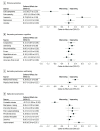Effect of Medical Marijuana Card Ownership on Pain, Insomnia, and Affective Disorder Symptoms in Adults: A Randomized Clinical Trial
- PMID: 35302633
- PMCID: PMC8933735
- DOI: 10.1001/jamanetworkopen.2022.2106
Effect of Medical Marijuana Card Ownership on Pain, Insomnia, and Affective Disorder Symptoms in Adults: A Randomized Clinical Trial
Abstract
Importance: Despite the legalization and widespread use of cannabis products for a variety of medical concerns in the US, there is not yet a strong clinical literature to support such use. The risks and benefits of obtaining a medical marijuana card for common clinical outcomes are largely unknown.
Objective: To evaluate the effect of obtaining a medical marijuana card on target clinical and cannabis use disorder (CUD) symptoms in adults with a chief concern of chronic pain, insomnia, or anxiety or depressive symptoms.
Design, setting, and participants: This pragmatic, single-site, single-blind randomized clinical trial was conducted in the Greater Boston area from July 1, 2017, to July 31, 2020. Participants were adults aged 18 to 65 years with a chief concern of pain, insomnia, or anxiety or depressive symptoms. Participants were randomized 2:1 to either the immediate card acquisition group (n = 105) or the delayed card acquisition group (n = 81). Randomization was stratified by chief concern, age, and sex. The statistical analysis followed an evaluable population approach.
Interventions: The immediate card acquisition group was allowed to obtain a medical marijuana card immediately after randomization. The delayed card acquisition group was asked to wait 12 weeks before obtaining a medical marijuana card. All participants could choose cannabis products from a dispensary, the dose, and the frequency of use. Participants could continue their usual medical or psychiatric care.
Main outcomes and measures: Primary outcomes were changes in CUD symptoms, anxiety and depressive symptoms, pain severity, and insomnia symptoms during the trial. A logistic regression model was used to estimate the odds ratio (OR) for CUD diagnosis, and linear models were used for continuous outcomes to estimate the mean difference (MD) in symptom scores.
Results: A total of 186 participants (mean [SD] age 37.2 [14.4] years; 122 women [65.6%]) were randomized and included in the analyses. Compared with the delayed card acquisition group, the immediate card acquisition group had more CUD symptoms (MD, 0.28; 95% CI, 0.15-0.40; P < .001); fewer self-rated insomnia symptoms (MD, -2.90; 95% CI, -4.31 to -1.51; P < .001); and reported no significant changes in pain severity or anxiety or depressive symptoms. Participants in the immediate card acquisition group also had a higher incidence of CUD during the intervention (17.1% [n = 18] in the immediate card acquisition group vs 8.6% [n = 7] in the delayed card acquisition group; adjusted odds ratio, 2.88; 95% CI, 1.17-7.07; P = .02), particularly those with a chief concern of anxiety or depressive symptoms.
Conclusions and relevance: This randomized clinical trial found that immediate acquisition of a medical marijuana card led to a higher incidence and severity of CUD; resulted in no significant improvement in pain, anxiety, or depressive symptoms; and improved self-rating of insomnia symptoms. Further investigation of the benefits of medical marijuana card ownership for insomnia and the risk of CUD are needed, particularly for individuals with anxiety or depressive symptoms.
Trial registration: ClinicalTrials.gov Identifier: NCT03224468.
Conflict of interest statement
Figures



References
-
- National Academies of Sciences, Engineering, and Medicine; Health and Medicine Division; Board on Population Health and Public Health Practice; Committee on the Health Effects of Marijuana: An Evidence Review and Research Agenda . The Health Effects of Cannabis and Cannabinoids. The Current State of Evidence and Recommendations for Research. National Academies Press; 2017. - PubMed

